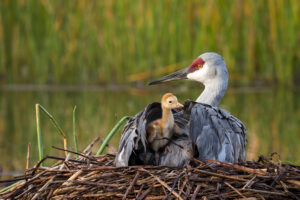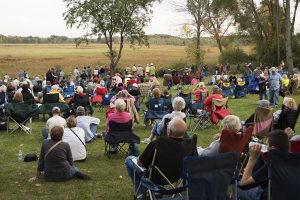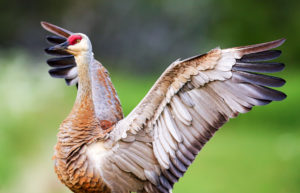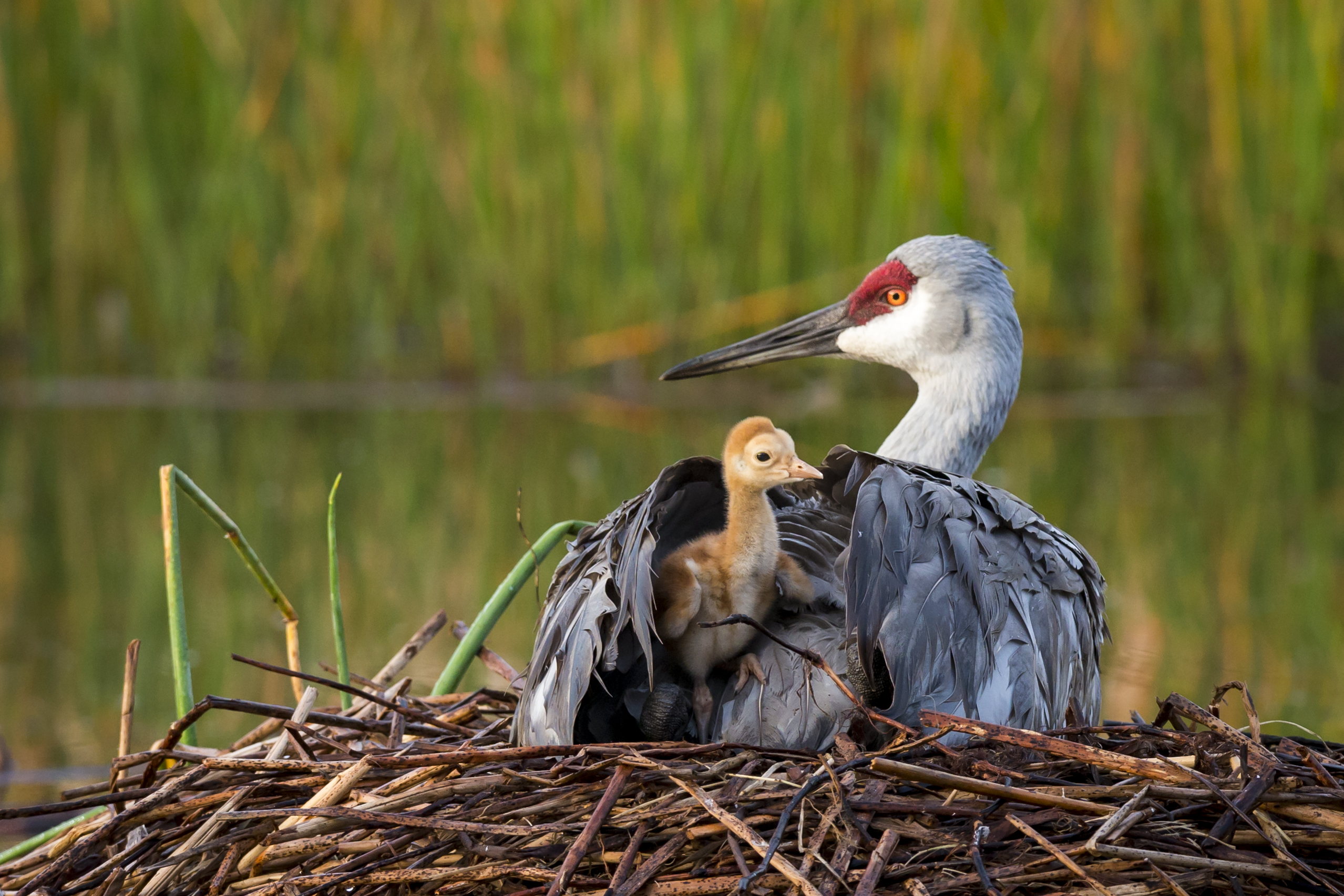Earlier in 2021, Senator McBroom presented Senate Resolution 20 to encourage the Natural Resources Commission to remove this species’ protected, non-game status and to add the Greater sandhill crane to the game species list in Michigan. At their March 3 meeting, the Senate Committee halted approving this resolution due to discrepancies and inconsistencies in both the data cited and rationale purported by the proposal. At a later date, the Committee approved a similar resolution, one that has been awaiting review by Michigan’s Natural Resources Commission (NRC). The NRC is preparing to hear a presentation on the Sandhill Crane from a Michigan DNR staff member, Barb Avers, on Thursday, October 14*. Click to view the NRC agenda and meeting details for October 14, 2021.
“This is a treasured species that simply doesn’t present a problem that hunting would solve, even if a far cry case can be made that their numbers suggest a viable hunt,” said Heather Good, Executive Director of Michigan Audubon. “We are again encouraging conservationists, ecologists, birdwatchers, and anyone in the state of Michigan who understands why this bird should remain a traditionally protected non-game bird to let your voice be heard.”
Michigan Audubon’s leadership, chapters, members, and supporters have steadily opposed repeated proposals to remove federal protections and hunt the sandhill crane. We believe the majority of Michigan residents would like to continue to see the Sandhill Crane protected as a traditional non-game (migratory) bird species in Michigan, too. We urge you to share your opinions about this issue to ensure more voices are heard. You can write to the 7-member Natural Resources Commission by emailing [email protected] and write to Governor Gretchen Whitmer here.

During the fall, you’ll typically see groups of three cranes. These groups of three are likely the parents and their young, or this year’s colt. © Lester Graham | Michigan Radio
How the Sandhill Crane Species Recovered in Michigan
Once nearly extinct from the Great Lakes region, Sandhill Cranes have undergone a population recovery over the past century, which is only a blink in this bird’s long history. Sandhill Cranes are believed to be the oldest living bird species, having existed for more than 2.5 million years in their present form. Michigan’s Sandhill Crane is still a recovering sub-species of the Greater Sandhill Crane. As stewards of the environment and Michigan’s natural resources, including wildlife, it is our duty to ensure the Sandhill Crane remains protected by the Migratory Bird Treaty Act and is not designated as a game species.
The continued recovery of the Sandhill Crane population is mostly attributed to their ability to adapt to converted agricultural landscapes in Michigan, coupled with hunting regulations and wetland protections that allowed this slow-reproducing species to thrive in the wild. Sandhill Cranes can be beneficial to farms at certain times of the year when they feed on agricultural pests and waste grain. However, cranes can also congregate in large numbers during the spring planting season, and in particular, locales cause damage to new shoots of corn.
The Logic of Opposing a Crane Hunt in Michigan
- Michigan’s Sandhill Crane remains at risk from several human disturbance factors, including:
- Fragmented habitats, particularly wetland habitats;
- The lack of suitable, preserved wetlands due to climate change, poor land use and planning, and human development;
- Complex, highly-changeable results of climate change on the bird’s range, breeding behavior, and projections related to reproductive success; and
- Having been hunted to near extinction relatively recently, Michigan Sandhill Cranes have a genetic bottleneck.
The Oxford English Dictionary defines conservation as “the preservation, protection, or restoration of the natural environment and of wildlife.” Conservation groups that have existed throughout Michigan’s history continue to advocate for the conservation and protection of birds like the Sandhill Crane that are a part of Michigan’s natural history, heritage, and ecosystems.
Conservation groups like Michigan Audubon have been speaking out against short-sighted, special interest (sport shooting) proposals for several years. “Claims made by proponents of a proposed crane hunt fail to understand key differences and data about migratory population ecology, reproductive biology, and wildlife management from a sustainability perspective,” said Heather Good, Michigan Audubon’s Executive Director. “We ought to reinforce, not remove, federal protections this bird has earned over the last century. It’s time that our state legislative leaders step up to the plate and make better, sounder, more balanced decisions for the sustainable future of Michigan’s rich natural history–for people and wildlife alike.”

Sandhill Crane. Photo by Mary Lundeberg | APA
2. Sandhill Cranes reproduce very slowly. Most pairs do not successfully nest until four to five years of age, lay only two eggs, and typically only one hatchling survives to fledge once every three years.
3. Hunting is not a solution for crop conflicts caused by Sandhill Cranes. Recreational fall hunting of Sandhill Cranes will not solve the problem of crane conflicts, which occur in the spring when the cranes can feed on the germinating corn seed shortly after initial planting.
4. Farmers already are permitted to shoot Sandhill Cranes in conflict on their farms, if eligible, using a depredation permit obtained from the Federal government. In 2019, more than 1,000 cranes were taken using these permits in Michigan. However, despite the prevalence of this permitted take, it has not reduced crop depredation – just as recreational hunting would not be an effective management tool. There is no evidence that a hunting season will address crop depredation in a meaningful way.
In 2019, depredation permits were issued for 2,092 Sandhill Cranes in Michigan and at least 1,428 were killed (over 10 % of the Michigan population according to table 1 of the 2020 U.S. Fish and Wildlife Service Fall Survey of the Eastern Population of Greater Sandhill Cranes). 2,385 depredation permits were issued in 2020, although the number actually killed that year is not currently available from the U.S. Fish and Wildlife Service.
5. It poses too much ecological risk. Although the eastern population of Sandhill Cranes is already hunted in a few states, the proposed change in status would lead to the first authorized hunt on core northern breeding grounds in the Midwest region. This poses different, and potentially significant risks for overharvesting local and genetically unique breeding populations of Sandhill Cranes, which have already suffered a significant genetic bottleneck due to near extirpation in Michigan. Managing a Sandhill Crane hunt to protect the important, still vulnerable breeding populations in Michigan will present significant challenges, including the need to identify the number and location of fall migratory birds in relation to local breeding birds in the state. The initiation of a hunt in northwest Minnesota in 2011, targeting the migratory Mid-Continent population of Sandhill Cranes that breed in the Northwest corner of that state, for example, led to a measurable population decline for that population for several years.
6. Establishing a hunt would be economically costly. The financial cost of a crane hunt would outweigh the financial benefit to most farmers and the State of Michigan. Avipel is affordable and widely available as a response to crop damage caused by cranes and other wildlife. We are committed to working with farmers, seed producers, legislators, and all others to make this non-toxic and non-lethal coating even more affordable to farmers planting corn near prime wetland habitat. A limited Sandhill Crane hunt would generate a low level of permit revenue, if at all. Program costs would likely increase for the purchase of damage prevention tools/supplies that are required and proven to work.
7. A recreational hunt would put other species, including the endangered Whooping Crane, at risk. The International Crane Foundation and partners have worked for 20 years to reintroduce the endangered Whooping Crane to Michigan and its flyway in the eastern United States. This small and young population is highly vulnerable to any deaths of adult breeding birds (read about the shooting of a breeding female in Indiana). Since the Whooping Crane Eastern Partnership established the Eastern Migratory Population of Whooping Cranes in 2001, at least one in 10 deaths was caused by shooting. This has clearly delayed the success of the reintroduction, and a Sandhill Crane hunt would likely increase the risk further.
Tell Governor Whitmer and members of the Natural Resource Commission that the voices of non-game wildlife supporters and conservationists matter, too. Together, we can encourage systemic change that embodies true conservation policies that preserve and protect our natural resources and vulnerable wildlife populations.

A crowd gathers to view migrating Sandhill Cranes return to Big Marsh Lake during the annual CraneFest event.
Michigan Audubon has actively helped to protect and recover the Sandhill Crane for 117 years, from establishing and overseeing annual crane counts to preserving suitable habitat for cranes to establishing and now sponsoring Michigan’s annual “CraneFest”, an outdoor festival in southwest Michigan that began in 1994. CraneFest takes place the second weekend of October and continues as an event hosted by the Kiwanis Club of Battle Creek. Thousands of people, not only birdwatchers, but members of the community and residents of Michigan gather and travel from out-of-state to watch these birds roost as they migrate in early fall.
“The Sandhill Crane’s numbers today don’t reflect a problem, ecologically speaking. We cannot discount the natural history of this species, and the fact that the Sandhill Crane’s recently stabilized numbers actually tell a Michigan conservation success story, one that we would be foolish, short-sighted, and disconnected from the principles of ecology to ignore or dismiss,” said Good. “Why would we take this success story and turn it on its head without due process and reliable science? This is a bird that wows and delights people, that brings them together economically; is widely depicted in art and celebrated as the largest and oldest avian species we enjoy in our state. Let’s give people an opportunity to weigh in on this decision if our wildlife protection legislators can’t do what they’re entrusted to do: uphold federal protections afforded to migratory birds by the Migratory Bird Treaty Act.”

Sandhill Crane by Sandy Powell
Organizations can sign on to Michigan Audubon’s letter urging the protection of the Sandhill Crane by completing the form here.
Residents of Michigan can sign our petition here:
Michigan Residents: Help us ensure your voice is heard in opposing hunting proposals and the removal of federal protections of the Sandhill Crane in Michigan.Petition Opposing Removing Federal Protections from the Sandhill Crane in Michigan

